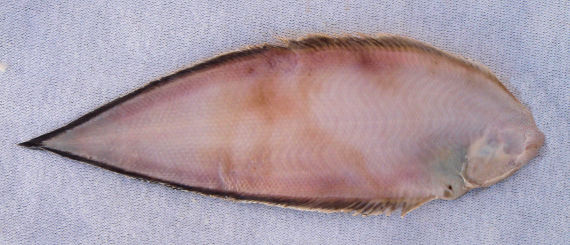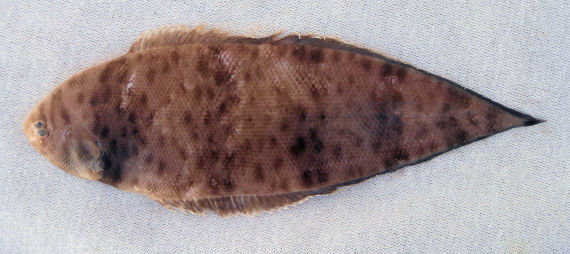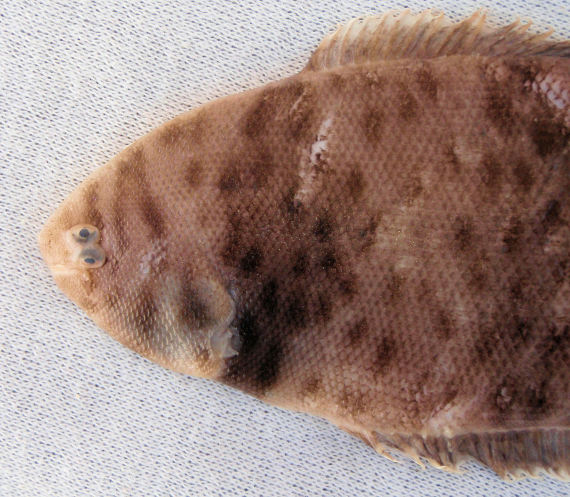Banded Tonguefish, Symphurus fasciolaris
 Banded Tonguefish, Symphurus fasciolaris. Fish provided by the commercial fishermen of the greater Los Cabos area, Baja California Sur, March 2011. Length: 22.0 cm (8.7 inches). This is a length extension for this species previously known to 16.7 cm (6.6 inches).
Banded Tonguefish, Symphurus fasciolaris. Fish provided by the commercial fishermen of the greater Los Cabos area, Baja California Sur, March 2011. Length: 22.0 cm (8.7 inches). This is a length extension for this species previously known to 16.7 cm (6.6 inches).
 Banded Tonguefish, Symphurus fasciolaris. Fish provided by by commercial fishermen of the greater Los Cabos area, Baja California Sur, June 2009. Length: 18 cm (7.1 inches).
Banded Tonguefish, Symphurus fasciolaris. Fish provided by by commercial fishermen of the greater Los Cabos area, Baja California Sur, June 2009. Length: 18 cm (7.1 inches).
The Banded Tonguefish, Symphurus fasciolaris, is a member of the Tonguefish or Cynoglossidae Family, and is known in Mexico as lengua listada. There are sixty-six global members of the genus Symphurus, of which twenty-three are found in Mexican waters, nine in the Atlantic and fourteen in the Pacific Ocean.
The Banded Tonguefish have elongated oval flat bodies that taper to a pointed tail with a body depth that is 28 to 32% of standard length. They have a tan coloration with six to eight fairly subtle wide dark bands and numerous small dark brown oval spots covering their body. Their anal and dorsal fins have indistinct dark bars at the rear and a narrow white outer margin. The tip of their caudal fin is black with a white margin. The inner operculum linings on both sides of their body are darkly pigmented. Their head has a rounded snout with a small curved mouth and small beady eyes on their left side, which are closely set together with the upper eye being slightly in front of the lower eye. Their anal and dorsal fins are confluent with their pointed caudal fin. Their anal fin has 75 to 80 rays; their dorsal fin has 90 to 97 rays and originates above the upper eye; they do not have pectoral fins; and, they only have a left pelvic fin. Their body is covered with rough scales. They do not have a lateral line.
The Banded Tonguefish are found over and within soft sandy and muddy bottoms at depths up to 150 m (500 feet). They are uniquely colored to blend with the substratum. They reach a maximum of 22.0 cm (8.7 inches) in length, as established by the fish photographed above. They feed on small fish and crustaceans. The Banded Tonguefish is poorly studied with very limited information available about their lifestyle and behavioral patterns including specific details on age, growth, longevity, movement patterns, diet, habitat use, and reproduction.
The Banded Tonguefish is a resident of all Mexican waters of the Pacific with the exception that they are absent from Guerrero Negro, Baja California, northward along the central and northwest coasts of Baja.
The Banded Tonguefish can be confused with the Halfspotted Tonguefish, Symphurus atramentatus (wide white bar at base of head and mid-back), the Chocolate Tonguefish, Symphurus callopterus (lacks bands), and the Whitetail Tonguefish, Symphurus oligomerus (lacks bands; wide white tail).
From a conservation perspective the Banded Tonguefish is currently considered to be of Least Concern with stable, widely distributed populations. They are small in stature and of limited interest to most.

